There’s always been a lot in common between the iPhone and Samsung’s Galaxy devices. With the Galaxy S10 line, announced by the company in San Francisco today, that connection is cemented in an oddly intimate fashion.
At a recent briefing about Samsung’s new phones, I slid the glossy back of my iPhone XS against the Galaxy S10+; it began sucking power from this new Android device. I realized we’d entered mostly uncharted territory here, where rival phones could share something fundamental: the actual energy surging through their batteries.
In the near-decade since the first Samsung Galaxy S line first appeared, Samsung and Apple have traded shots in a constant game of one-upmanship. When Samsung offered an “Infinity Display” with the Galaxy S8, Apple responded with a nearly edge-to-edge, notched OLED screen on the iPhone X. This back-and-forth has resulted in a convergence, with each company delivering gleaming glass and metal slabs that threaten to become indistinguishable from one another.
With its new collection of four Galaxy S10 devices — the 6.1-inch Samsung Galaxy S10, 6.4-inch Galaxy S10+, the 5.8-inch Galaxy S10e, and the 6.7-inch Galaxy S10 5G — Samsung has managed to distinguish itself while also demonstrating how smartphones have cohered around some similar ideas.

Left to right: the Samsung Galaxy S10, S10+, and S10e
Samsung’s new S10 handsets are all gorgeous, sleek, and roughly the same size as their predecessors. They also include a handful of innovations and feature choices that instantly set the new phones apart. There’s the aforementioned ability to share power directly with other Qi-based devices — officially dubbed Wireless PowerShare — a fingerprint reader that’s completely hidden under the screen, holes punched directly through the display to accommodate a selfie camera, and, yes, even 3.5 mm headphone jacks.
Let’s get into specifics.
The screens
Samsung prides itself on its display technology. It never succumbed to the “notch” trend, going so far as to make fun of Apple for the iPhone X’s design in a series of commercials. Without that notch, though, Samsung could never achieve the dream of a truly edge-to-edge display. In the S9, the screen simply stopped well-short of the top edge of the phone to accommodate an array of cameras and sensors.
To be fair, notch or no notch, I have yet to see a smartphone display that truly reaches every edge of a phone. The recent iPhone displays have a thin black bar running around them, as does the Galaxy S10 line.
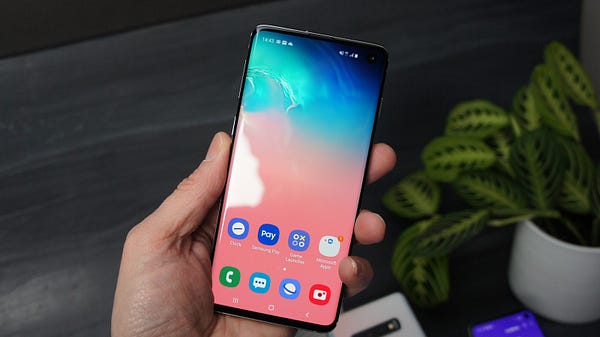
Samsung Galaxy S10 is all screen
Still, with the Galaxy S10, S10+, S10 5G, and the more diminutive S10e, Samsung has come closer to realizing its edge-to-edge ambitions.
The new dynamic AMOLED screen now supports HDR10+, and all but the S10e support a resolution dubbed “Wide Quad HD” (2560 x 1440); the S10e offers Full HD+ (1920x1080). In person, the Next Level Infinity Display is gorgeous on all three devices, with brilliant colors, inky blacks, and the ability to beat back almost all light shining directly on it. The company didn’t show me the 5G model, which offers a slightly larger screen and battery, but is otherwise the same as the Samsung Galaxy S10+.
According to Samsung, the displays can also cut out 42 percent of blue light without the use of a filter, which could help reduce eye fatigue.
Unlike an iPhone, the Galaxy S10 and S10+ screens are not totally flat. There’s a slightly chamfered edge on each side (and on the back), which makes even the larger S10+ comfortable to hold. The exception in the new lineup is the smaller S10e, which has a totally flat screen.
The Infinity Displays reach about as close to the top and bottom edges of all three phones as possible, though yes, some of the surrounding bezel shows through. Somehow, the top edge of the thin black bar that runs around all the screens also accommodates a nearly imperceptible speaker.
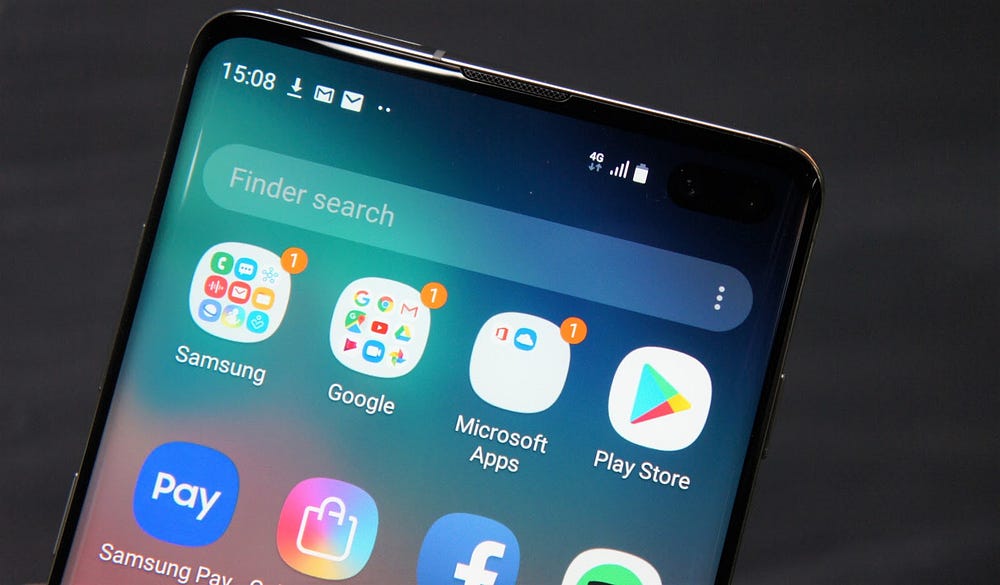
Yes, that’s a tiny speaker on the top edge of the Galaxy S10+.
Even with all that screen real estate, there’s a camera on the face of each phone. In fact, there are two on the S10+. Instead of notching out a space, or leaving a large black bar at the top, Samsung figured out how to laser cut through the AMOLED without damaging the display, to leave space for the front-facing cameras. The camera holes are in the upper right corner of each phone’s screen.
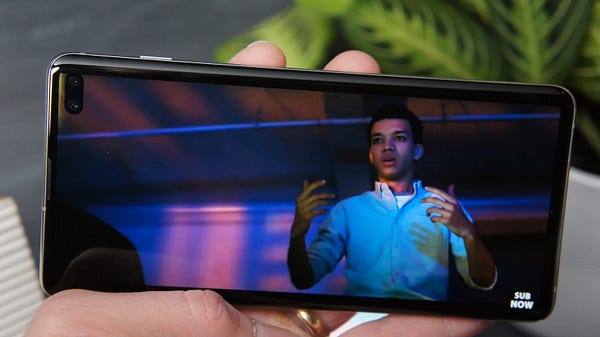
If you play full-screen video on the Galaxy S10+, you might notice the camera cutout.
Looking at the three devices, my immediate concern was how images, video, and games would look with those little black circles in them. They’re not totally distracting, and I could run most videos at a size that avoided running under the cutouts entirely. Still, it’s a bold choice that may worry some, especially the gamers that the larger S10+ is targeting.
More exciting is that the Galaxy S10 line is really the first mainstream set of Android devices to offer under-the-display fingerprint readers. Recent Galaxy phones placed the fingerprint reader on the back of the device, next to the camera lens, which made them a bit tricky to use. Now, there’s an ultrasonic fingerprint sensor under each Next Level Infinity Display, positioned roughly a centimeter from the bottom edge of the screen.
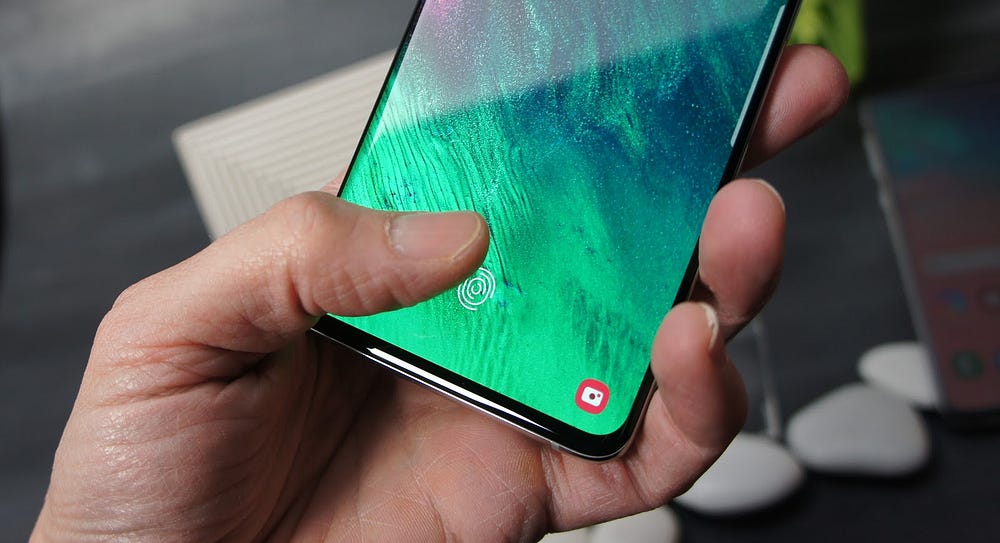
No visible sensor, no problem. All three phones have the fingerprint scanner hidden under the screen.
Like a standard fingerprint sensor, you register your finger by repeatedly holding it down on the sensor space until the screen tells you your fingerprint is registered. It was a little strange doing it on the screen instead of visible sensing hardware, like the home button on older iPhones, but only once did the menu recommend I press a little harder. There are visual cues showing you where to place your finger on the screen, but Samsung claims muscle memory will make it easy for people to remember how to use the feature.
According to Samsung, all fingerprint data is stored locally on the phone in its defense-grade “TrustZone.”
The devices also still include facial recognition technology, and the now-standard heart rate sensor remains on the back as part of the camera module.
Cameras
The back-camera cluster has grown considerably into a three-camera, wide-body configuration that, on the Galaxy S10 and S10+, is almost an 1.5-inch wide.
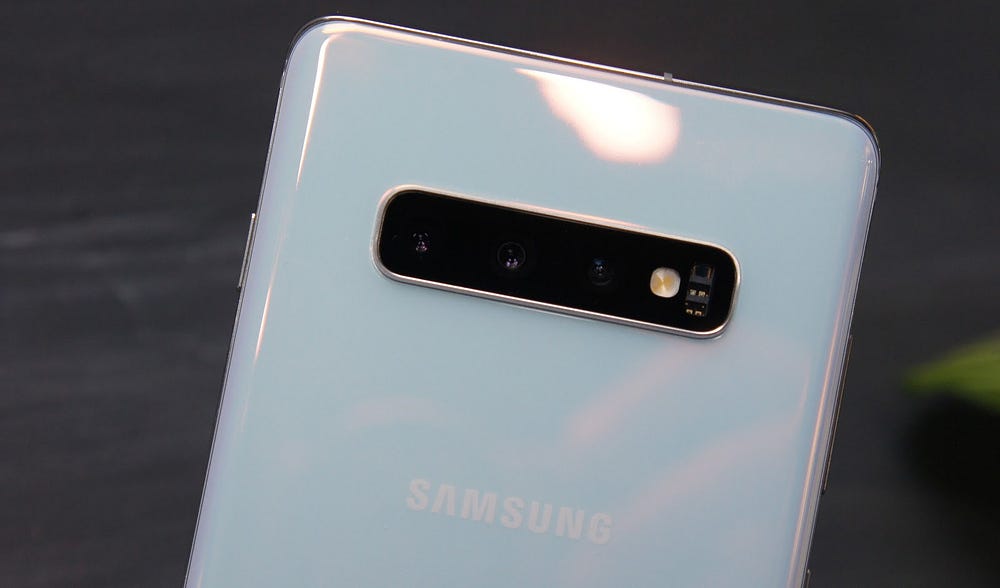
The Galaxy S10 and S10+ have three cameras, a flash, and the heart rate sensor on the back.
The Galaxy S10 and S10+ camera modules feature a 16 MP, 123-degree ultra-wide lens, a Dual Pixel 12 MP 77-degree wide-angle lens, and a 12 MP 2X telephoto lens. Both f2.4, 12 MP lenses include optical image stabilization. The Galaxy S10e is a little more conservative, with just the 16 MP ultra-wide and 12 MP wide.
As for the selfie cam, both the Galaxy S10e and S10 have the single, dual-pixel 10 MP lens on the front, while the Galaxy S10+ has the 10 MP and an 8 MP depth camera.
Overall, the rear camera configuration look is a little less elegant than on previous Galaxy devices (and certainly than on any iPhone X models), but I think the image quality will soften that blow.
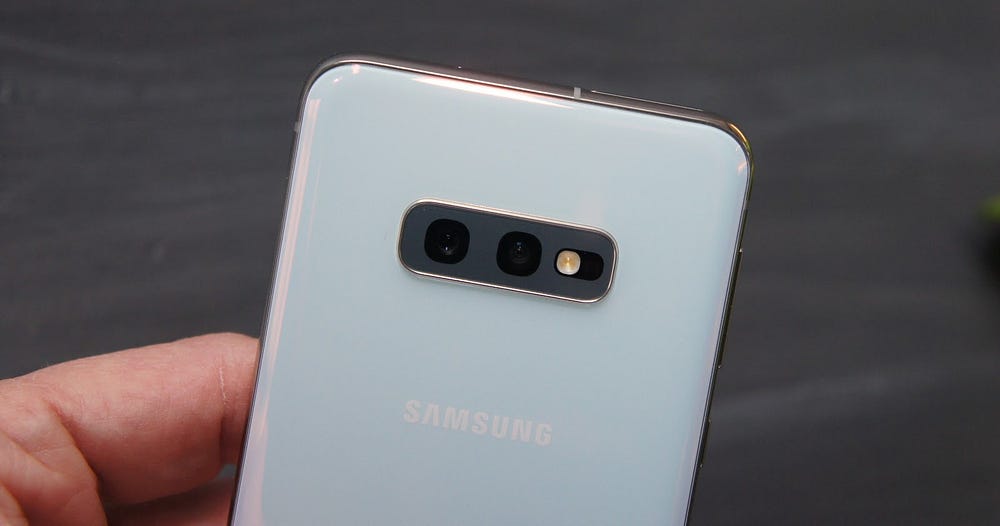
The smaller (and cheaper) S10e has two cameras on the back.
I tried all three cameras and noticed immediately that Samsung has updated its Camera and Gallery icons and, once again, simplified its Camera app. Samsung has spent years reducing menu and feature clutter in its camera apps, and definitely hit a high note with the version I found on the Galaxy S9 and Galaxy S9 Note.
The camera app on the S10, 10+, and S10e is simpler, but I can’t say I liked the lens switching iconography. After selecting “photo,” I went hunting for a list of lens choices. Instead, I saw a set of icons with one, two, and three trees — or at least what looked like trees. That’s how you switch between wide, ultra-wide, and zoom settings. Of course, I could also use a pinch gesture on the screen to switch to 2x zoom.
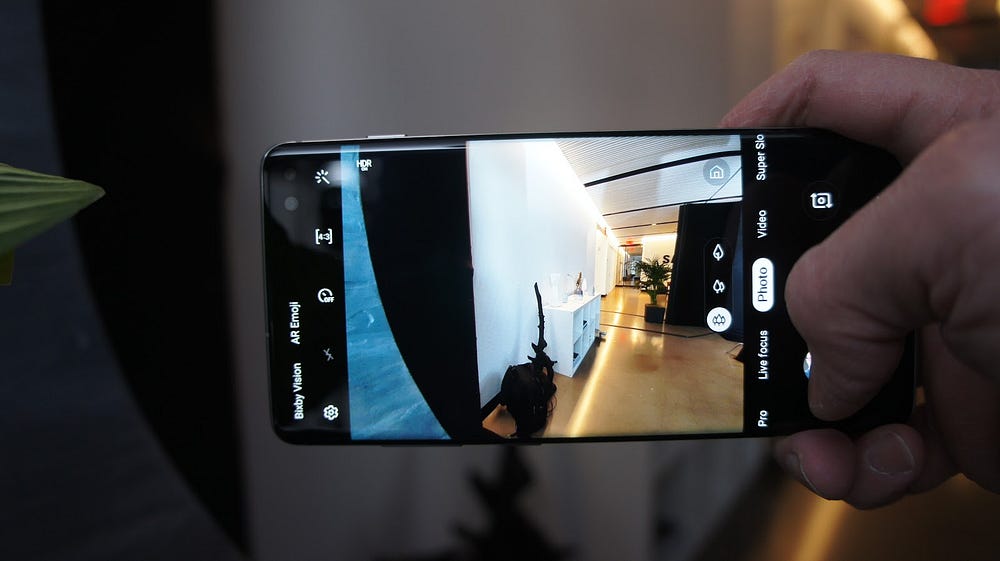
The updated Camera App has some odd lens selection iconography.
The wide-angle camera captures a decent amount of the scene, but the ultra-wide borders on a fish-eye effect.
Samsung is also updating the “Scene Optimizer” it launched with Note 9. It said the mobile CPU’s new, onboard neural processor will help it identify even more objects. Plus, there’s a new “Shot Suggestions” tool that will help less-adept photographers frame up better photos. You can toggle this option on and off.
Performance and battery
I’ve tested a lot of Samsung and Apple phones, and while they both make excellent devices, Samsung’s reliance on Qualcomm’s Snapdragon line has usually placed it a step or two behind Apple in performance. That could change with the Galaxy S10 phones, which are built around an Octa-core, 7 nanometer processor that I have to assume is Qualcomm’s new Snapdragon 855 (at press time, Samsung would not confirm). The 7 nm process, Octa-core CPU has, much like Apple’s A12 Bionic, an onboard neural engine that, in combination with the devices’ built-in time-of flight 3D scanner, should produce some eye-popping augmented reality experiences. It will finally match (or beat) Apple’s bespoke CPU in overall performance.
All three phones start with 128GB of storage (Apple’s iPhone XS line starts at 64GB), but the S10+ can bump up to 1TB of storage and can go even higher with the addition of a micro SD card. The Galaxy S10 and S10+ have 8GB of RAM. The S10e starts with 6GB of RAM and 128GB of storage; it tops out at 256GB of storage and 8GB of RAM.
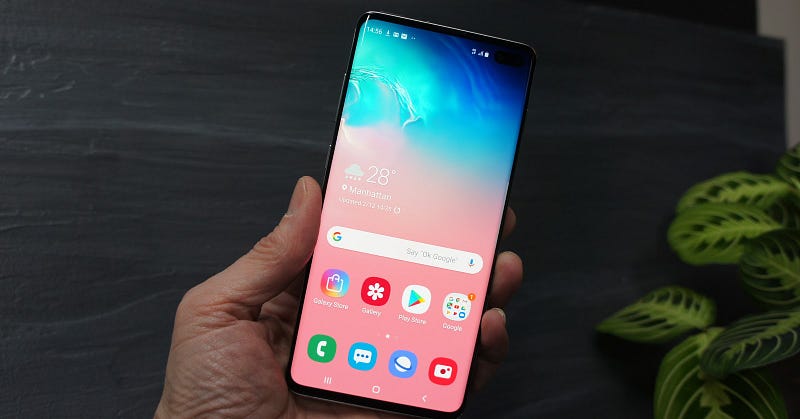
The Galaxy S10+ has a 4,100 mAh battery.
While battery sizes vary across the three devices — 3,100 mAh on the S10e, 3,400 mAh on the S10, 4,100 mAh on the S10+, and 4,500 mAh on the 5G model — Samsung is promising 24 hours of battery life across the lineup. This is due in part to some smart battery management software. According to Samsung, the S10 phones will track usage patterns and preload the software you use, and if you don’t use certain apps all day long, it will shut down those apps so they don’t consume battery life. (It’s unclear at this point how this might impact apps you may not open frequently but rely on to run in the background for relevant notifications — inclement weather updates from Dark Sky, for example.)
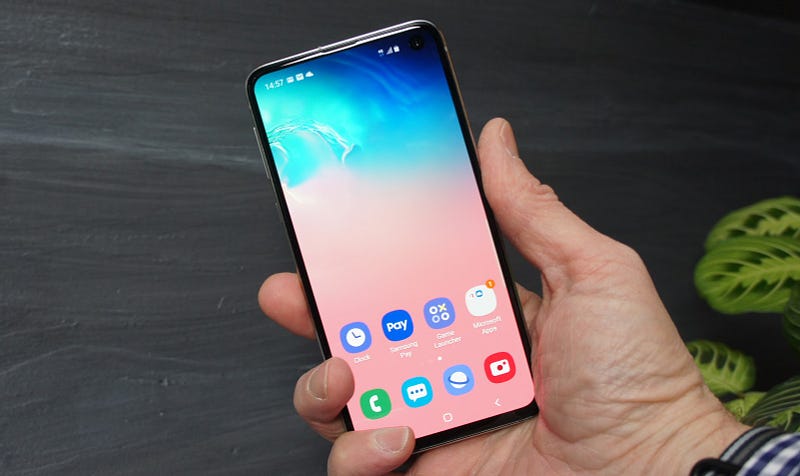
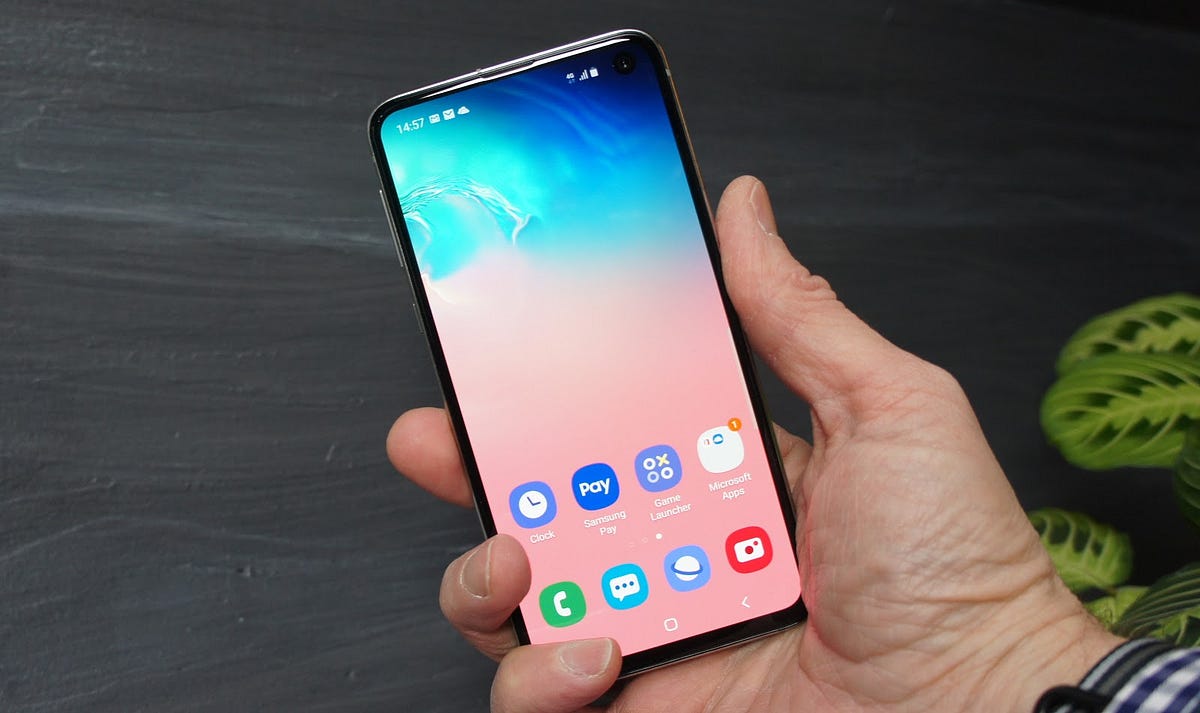
The Galaxy S10e is small in size, battery life, and price.
There’s also something new called “Bixby Routines,” which reminded me a little of Apple’s Siri Shortcuts. Bixby, Samsung’s digital assistant, builds routines based around how you use your device — a pre-built one, for example, can turn off WiFi and start Spotify when it recognizes you’re driving.
The system will also optimize CPU and RAM usage to improve overall battery life.


Take that AirPods, these are Samsung’s new Galaxy Buds.
Of course, the most exciting thing in the power space is Wireless PowerShare. It allows any of the Galaxy S10 phones to charge any other Qi-based, wirelessly chargeable device. This means, obviously, other Galaxy phones and, yes, recent Qi-supporting iPhone models.
It also includes another new Samsung accessory: Samsung Galaxy Buds, Bluetooth competitors to AirPods. The wireless charge is actually picked up by the case, and the Buds themselves have 6 hours of battery life. Samsung told me the new Buds include dual microphones and AKG sound.
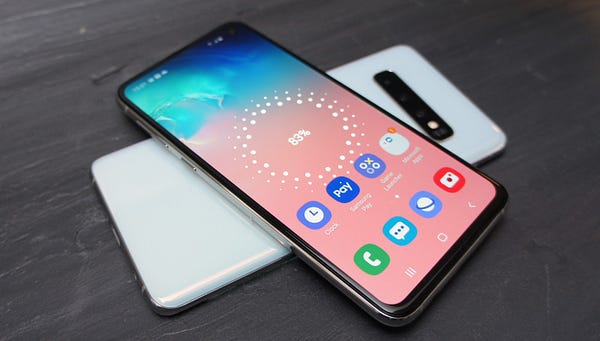
The Galaxy S10e is sucking power from the S10+ below it using PowerShare.
As I mentioned, I tried out Wireless PowerShare on the Galaxy S10+. To use it, I long-dragged the settings menu from the top of the screen and then selected the Wireless PowerShare icon. The on-screen menu directed me to flip the phone over and place a Qi-compatible device on its back. As soon as I put the Galaxy S10 on it, it indicated that it was charging up. And I could see it working just as well with my iPhone XS.
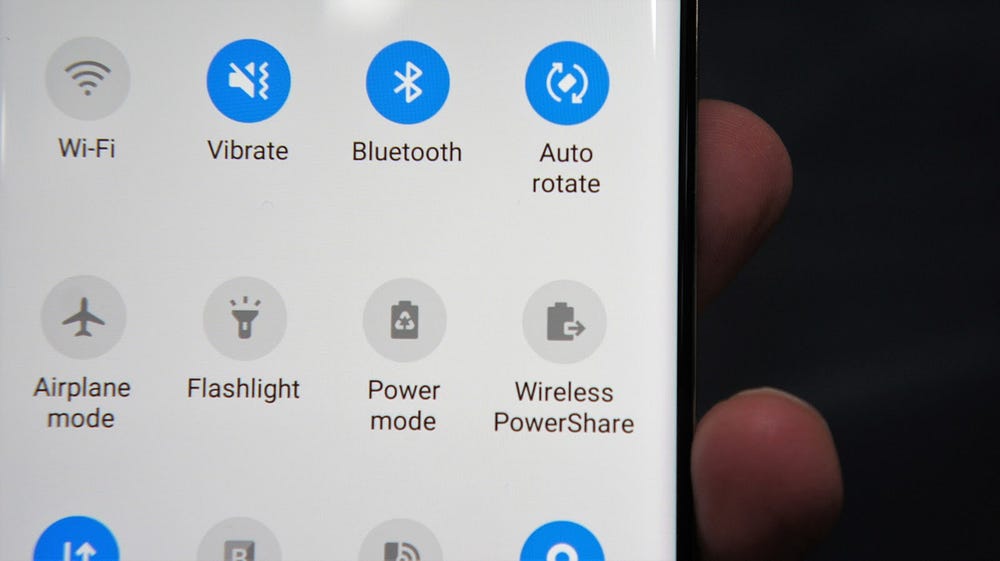
The new Wireless PowerShare icon.
Wireless PowerShare does not change the Fast Wireless Charging 2.0 capabilities, which Samsung says will work just as well as before to charge the smartphone almost as fast as a wired connection. In addition, PowerShare can’t fully drain your S10 device; the phone will stop sharing power when the battery level drops to 30 percent.
The Rest
While the three phones share many of the same features, they are being aimed at slightly different markets. The $899 Galaxy S10 is a sort of sweet-spot device with almost all of Samsung’s top-end technology (except that front-facing depth camera and bigger battery) but at a more manageable size. The $749.99 S10e is about size and affordability and is clearly a more direct competitor to Apple’s surprisingly popular and more affordable iPhone XR.
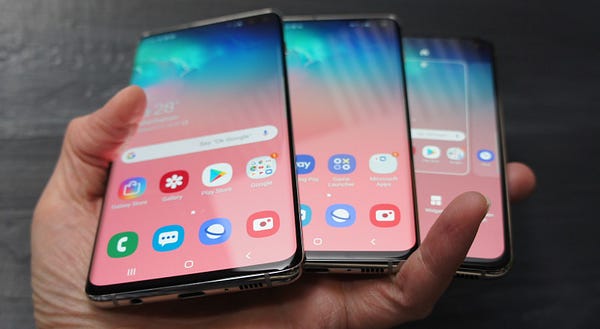
Samsung’s actually releasing four phones. The 6.7-inch S10 5G is not pictured.
The $999 Samsung Galaxy S10+ is Samsung’s everything-but-the-kitchen-sink of the line, and, in addition to the Dolby Atmos-supporting stereo speakers and support for the Unity Gaming Engine, it adds at least one feature aimed directly at gamers: vapor chamber cooling.
The S10 line also begins the mainstream rollout of true 5G. Samsung will start selling a 6.7-inch Samsung Galaxy S10 5G exclusively on Verizon later this year. It’s unclear if Verizon’s mobile 5G network will actually be ready in time (they’re rolling it out in homes, first), but it’s hard to imagine 5G won’t work in at least a few markets. Samsung said that the S10 5G will be available with other carriers over time.
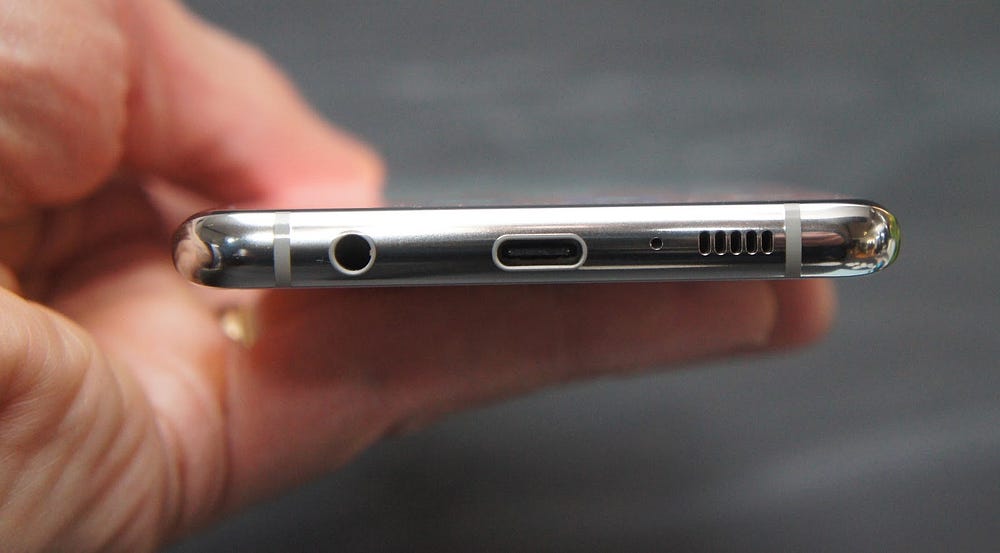
If you want a 3.5 mm headphone Alex, the Galaxy S10 line has you covered.
There are also a few new colors: Flamingo Pink, Prism Black, White, and Blue in the U.S., with the addition of Prism Green globally.
While it’s too soon to tell if Samsung’s Galaxy S10 line is the new benchmark for mobile technology, it is clear that Samsung is sending Apple a message: We’ll do display, connectivity, and security innovation our way and on our terms. Are you ready to play catch up?
Preorders for the Samsung Galaxy S10, S10+, and S10e start on February 21, and they hit stores on March 8. And for those who do preorder the phones, Samsung is throwing in a pair of the new Buds, which would normally cost $129.
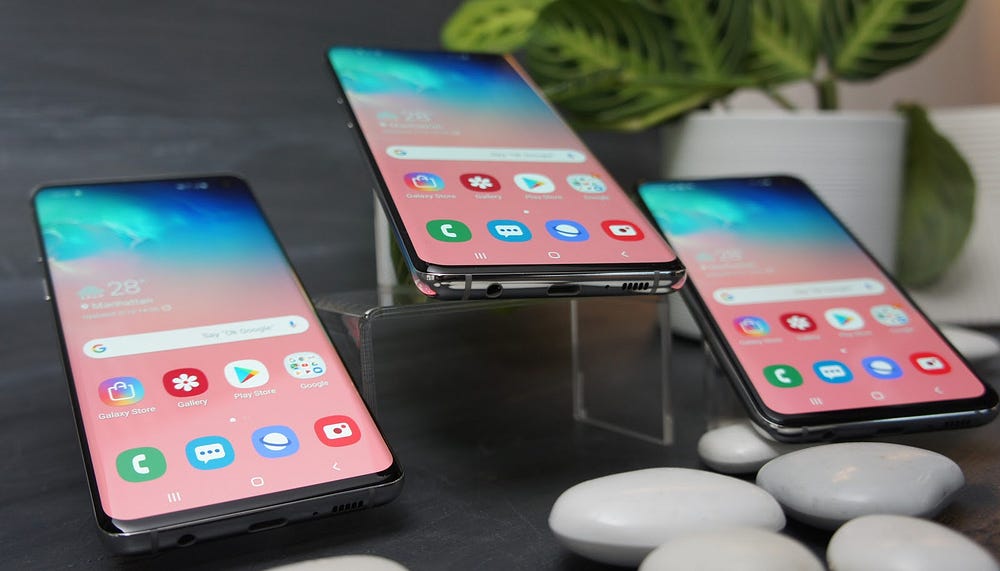
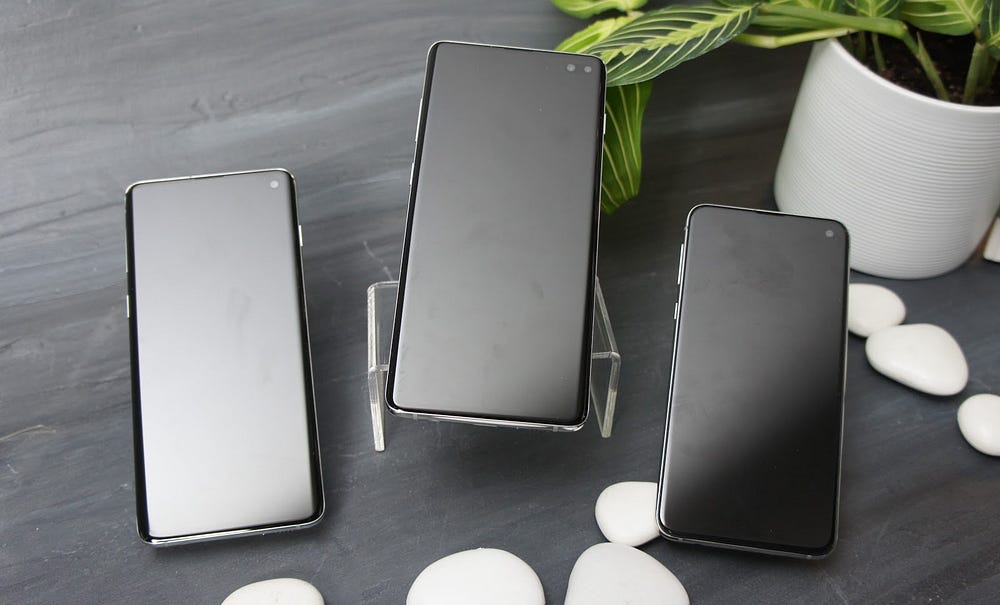
At a recent briefing about Samsung’s new phones, I slid the glossy back of my iPhone XS against the Galaxy S10+; it began sucking power from this new Android device. I realized we’d entered mostly uncharted territory here, where rival phones could share something fundamental: the actual energy surging through their batteries.
In the near-decade since the first Samsung Galaxy S line first appeared, Samsung and Apple have traded shots in a constant game of one-upmanship. When Samsung offered an “Infinity Display” with the Galaxy S8, Apple responded with a nearly edge-to-edge, notched OLED screen on the iPhone X. This back-and-forth has resulted in a convergence, with each company delivering gleaming glass and metal slabs that threaten to become indistinguishable from one another.
With its new collection of four Galaxy S10 devices — the 6.1-inch Samsung Galaxy S10, 6.4-inch Galaxy S10+, the 5.8-inch Galaxy S10e, and the 6.7-inch Galaxy S10 5G — Samsung has managed to distinguish itself while also demonstrating how smartphones have cohered around some similar ideas.
Left to right: the Samsung Galaxy S10, S10+, and S10e
Samsung’s new S10 handsets are all gorgeous, sleek, and roughly the same size as their predecessors. They also include a handful of innovations and feature choices that instantly set the new phones apart. There’s the aforementioned ability to share power directly with other Qi-based devices — officially dubbed Wireless PowerShare — a fingerprint reader that’s completely hidden under the screen, holes punched directly through the display to accommodate a selfie camera, and, yes, even 3.5 mm headphone jacks.
Let’s get into specifics.
The screens
Samsung prides itself on its display technology. It never succumbed to the “notch” trend, going so far as to make fun of Apple for the iPhone X’s design in a series of commercials. Without that notch, though, Samsung could never achieve the dream of a truly edge-to-edge display. In the S9, the screen simply stopped well-short of the top edge of the phone to accommodate an array of cameras and sensors.
To be fair, notch or no notch, I have yet to see a smartphone display that truly reaches every edge of a phone. The recent iPhone displays have a thin black bar running around them, as does the Galaxy S10 line.
Samsung Galaxy S10 is all screen
Still, with the Galaxy S10, S10+, S10 5G, and the more diminutive S10e, Samsung has come closer to realizing its edge-to-edge ambitions.
The new dynamic AMOLED screen now supports HDR10+, and all but the S10e support a resolution dubbed “Wide Quad HD” (2560 x 1440); the S10e offers Full HD+ (1920x1080). In person, the Next Level Infinity Display is gorgeous on all three devices, with brilliant colors, inky blacks, and the ability to beat back almost all light shining directly on it. The company didn’t show me the 5G model, which offers a slightly larger screen and battery, but is otherwise the same as the Samsung Galaxy S10+.
According to Samsung, the displays can also cut out 42 percent of blue light without the use of a filter, which could help reduce eye fatigue.
Unlike an iPhone, the Galaxy S10 and S10+ screens are not totally flat. There’s a slightly chamfered edge on each side (and on the back), which makes even the larger S10+ comfortable to hold. The exception in the new lineup is the smaller S10e, which has a totally flat screen.
The Infinity Displays reach about as close to the top and bottom edges of all three phones as possible, though yes, some of the surrounding bezel shows through. Somehow, the top edge of the thin black bar that runs around all the screens also accommodates a nearly imperceptible speaker.
Yes, that’s a tiny speaker on the top edge of the Galaxy S10+.
Even with all that screen real estate, there’s a camera on the face of each phone. In fact, there are two on the S10+. Instead of notching out a space, or leaving a large black bar at the top, Samsung figured out how to laser cut through the AMOLED without damaging the display, to leave space for the front-facing cameras. The camera holes are in the upper right corner of each phone’s screen.
If you play full-screen video on the Galaxy S10+, you might notice the camera cutout.
Looking at the three devices, my immediate concern was how images, video, and games would look with those little black circles in them. They’re not totally distracting, and I could run most videos at a size that avoided running under the cutouts entirely. Still, it’s a bold choice that may worry some, especially the gamers that the larger S10+ is targeting.
More exciting is that the Galaxy S10 line is really the first mainstream set of Android devices to offer under-the-display fingerprint readers. Recent Galaxy phones placed the fingerprint reader on the back of the device, next to the camera lens, which made them a bit tricky to use. Now, there’s an ultrasonic fingerprint sensor under each Next Level Infinity Display, positioned roughly a centimeter from the bottom edge of the screen.
No visible sensor, no problem. All three phones have the fingerprint scanner hidden under the screen.
Like a standard fingerprint sensor, you register your finger by repeatedly holding it down on the sensor space until the screen tells you your fingerprint is registered. It was a little strange doing it on the screen instead of visible sensing hardware, like the home button on older iPhones, but only once did the menu recommend I press a little harder. There are visual cues showing you where to place your finger on the screen, but Samsung claims muscle memory will make it easy for people to remember how to use the feature.
According to Samsung, all fingerprint data is stored locally on the phone in its defense-grade “TrustZone.”
The devices also still include facial recognition technology, and the now-standard heart rate sensor remains on the back as part of the camera module.
Cameras
The back-camera cluster has grown considerably into a three-camera, wide-body configuration that, on the Galaxy S10 and S10+, is almost an 1.5-inch wide.
The Galaxy S10 and S10+ have three cameras, a flash, and the heart rate sensor on the back.
The Galaxy S10 and S10+ camera modules feature a 16 MP, 123-degree ultra-wide lens, a Dual Pixel 12 MP 77-degree wide-angle lens, and a 12 MP 2X telephoto lens. Both f2.4, 12 MP lenses include optical image stabilization. The Galaxy S10e is a little more conservative, with just the 16 MP ultra-wide and 12 MP wide.
As for the selfie cam, both the Galaxy S10e and S10 have the single, dual-pixel 10 MP lens on the front, while the Galaxy S10+ has the 10 MP and an 8 MP depth camera.
Overall, the rear camera configuration look is a little less elegant than on previous Galaxy devices (and certainly than on any iPhone X models), but I think the image quality will soften that blow.
The smaller (and cheaper) S10e has two cameras on the back.
I tried all three cameras and noticed immediately that Samsung has updated its Camera and Gallery icons and, once again, simplified its Camera app. Samsung has spent years reducing menu and feature clutter in its camera apps, and definitely hit a high note with the version I found on the Galaxy S9 and Galaxy S9 Note.
The camera app on the S10, 10+, and S10e is simpler, but I can’t say I liked the lens switching iconography. After selecting “photo,” I went hunting for a list of lens choices. Instead, I saw a set of icons with one, two, and three trees — or at least what looked like trees. That’s how you switch between wide, ultra-wide, and zoom settings. Of course, I could also use a pinch gesture on the screen to switch to 2x zoom.
The updated Camera App has some odd lens selection iconography.
The wide-angle camera captures a decent amount of the scene, but the ultra-wide borders on a fish-eye effect.
Samsung is also updating the “Scene Optimizer” it launched with Note 9. It said the mobile CPU’s new, onboard neural processor will help it identify even more objects. Plus, there’s a new “Shot Suggestions” tool that will help less-adept photographers frame up better photos. You can toggle this option on and off.
Performance and battery
I’ve tested a lot of Samsung and Apple phones, and while they both make excellent devices, Samsung’s reliance on Qualcomm’s Snapdragon line has usually placed it a step or two behind Apple in performance. That could change with the Galaxy S10 phones, which are built around an Octa-core, 7 nanometer processor that I have to assume is Qualcomm’s new Snapdragon 855 (at press time, Samsung would not confirm). The 7 nm process, Octa-core CPU has, much like Apple’s A12 Bionic, an onboard neural engine that, in combination with the devices’ built-in time-of flight 3D scanner, should produce some eye-popping augmented reality experiences. It will finally match (or beat) Apple’s bespoke CPU in overall performance.
All three phones start with 128GB of storage (Apple’s iPhone XS line starts at 64GB), but the S10+ can bump up to 1TB of storage and can go even higher with the addition of a micro SD card. The Galaxy S10 and S10+ have 8GB of RAM. The S10e starts with 6GB of RAM and 128GB of storage; it tops out at 256GB of storage and 8GB of RAM.
The Galaxy S10+ has a 4,100 mAh battery.
While battery sizes vary across the three devices — 3,100 mAh on the S10e, 3,400 mAh on the S10, 4,100 mAh on the S10+, and 4,500 mAh on the 5G model — Samsung is promising 24 hours of battery life across the lineup. This is due in part to some smart battery management software. According to Samsung, the S10 phones will track usage patterns and preload the software you use, and if you don’t use certain apps all day long, it will shut down those apps so they don’t consume battery life. (It’s unclear at this point how this might impact apps you may not open frequently but rely on to run in the background for relevant notifications — inclement weather updates from Dark Sky, for example.)
The Galaxy S10e is small in size, battery life, and price.
There’s also something new called “Bixby Routines,” which reminded me a little of Apple’s Siri Shortcuts. Bixby, Samsung’s digital assistant, builds routines based around how you use your device — a pre-built one, for example, can turn off WiFi and start Spotify when it recognizes you’re driving.
The system will also optimize CPU and RAM usage to improve overall battery life.
Take that AirPods, these are Samsung’s new Galaxy Buds.
Of course, the most exciting thing in the power space is Wireless PowerShare. It allows any of the Galaxy S10 phones to charge any other Qi-based, wirelessly chargeable device. This means, obviously, other Galaxy phones and, yes, recent Qi-supporting iPhone models.
It also includes another new Samsung accessory: Samsung Galaxy Buds, Bluetooth competitors to AirPods. The wireless charge is actually picked up by the case, and the Buds themselves have 6 hours of battery life. Samsung told me the new Buds include dual microphones and AKG sound.
The Galaxy S10e is sucking power from the S10+ below it using PowerShare.
As I mentioned, I tried out Wireless PowerShare on the Galaxy S10+. To use it, I long-dragged the settings menu from the top of the screen and then selected the Wireless PowerShare icon. The on-screen menu directed me to flip the phone over and place a Qi-compatible device on its back. As soon as I put the Galaxy S10 on it, it indicated that it was charging up. And I could see it working just as well with my iPhone XS.
The new Wireless PowerShare icon.
Wireless PowerShare does not change the Fast Wireless Charging 2.0 capabilities, which Samsung says will work just as well as before to charge the smartphone almost as fast as a wired connection. In addition, PowerShare can’t fully drain your S10 device; the phone will stop sharing power when the battery level drops to 30 percent.
The Rest
While the three phones share many of the same features, they are being aimed at slightly different markets. The $899 Galaxy S10 is a sort of sweet-spot device with almost all of Samsung’s top-end technology (except that front-facing depth camera and bigger battery) but at a more manageable size. The $749.99 S10e is about size and affordability and is clearly a more direct competitor to Apple’s surprisingly popular and more affordable iPhone XR.
Samsung’s actually releasing four phones. The 6.7-inch S10 5G is not pictured.
The $999 Samsung Galaxy S10+ is Samsung’s everything-but-the-kitchen-sink of the line, and, in addition to the Dolby Atmos-supporting stereo speakers and support for the Unity Gaming Engine, it adds at least one feature aimed directly at gamers: vapor chamber cooling.
The S10 line also begins the mainstream rollout of true 5G. Samsung will start selling a 6.7-inch Samsung Galaxy S10 5G exclusively on Verizon later this year. It’s unclear if Verizon’s mobile 5G network will actually be ready in time (they’re rolling it out in homes, first), but it’s hard to imagine 5G won’t work in at least a few markets. Samsung said that the S10 5G will be available with other carriers over time.
If you want a 3.5 mm headphone Alex, the Galaxy S10 line has you covered.
There are also a few new colors: Flamingo Pink, Prism Black, White, and Blue in the U.S., with the addition of Prism Green globally.
While it’s too soon to tell if Samsung’s Galaxy S10 line is the new benchmark for mobile technology, it is clear that Samsung is sending Apple a message: We’ll do display, connectivity, and security innovation our way and on our terms. Are you ready to play catch up?
Preorders for the Samsung Galaxy S10, S10+, and S10e start on February 21, and they hit stores on March 8. And for those who do preorder the phones, Samsung is throwing in a pair of the new Buds, which would normally cost $129.
